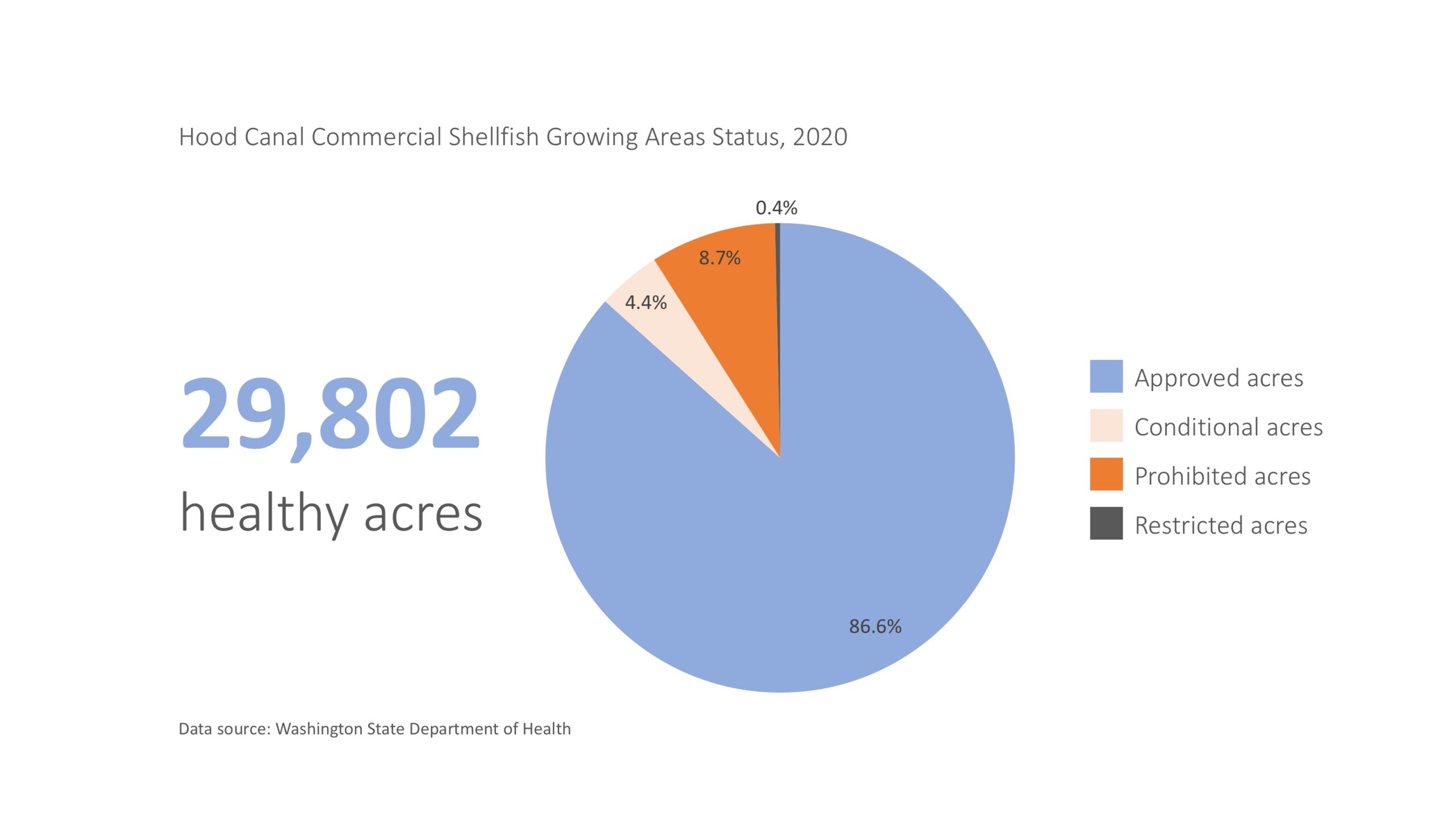The HCSI brought together shellfish partners to develop a plan that protect shellfish populations and ensures they continue to support a healthy ecosystem and community
Hood Canal Shellfish
Shellfish are essential to the culture, identity, and economy of the Hood Canal region. They provide important environmental values by protecting shorelines and cleaning waters. Native shellfish include geoduck, littleneck, horse, butter, cockle, and bentnose clams; Olympia oysters; and blue mussels and naturalized bivalves (e.g., Pacific oyster and Manila clam), excluding crabs and shrimp. Shellfish thrive in clean water and are a key element of a healthy and functional Hood Canal ecosystem.
Established and productive shellfish populations provide many ecosystem services:
- Stabilize marine sediments and shorelines
- Improve water quality and clarity through bio-filtration
- Provide structural habitat for other nearshore and marine organisms
Shellfish are also a cultural cornerstone in the region. We value shellfish because they provide opportunities for:
- Subsistence harvest for Native American tribes
- Ceremonial harvest and maintenance of cultural heritage
- Recreational harvest
- Tourism (e.g., motel and restaurant visits, rentals, license fees, etc.)
- Commercial shellfish operators
- Nearshore habitat restoration and enhancement
Hood Canal Shellfish Initiative (HCSI)
Indicators
Shellfish Growing Areas
TARGET: All harvestable shellfish beds in Hood Canal are open and in good health.
Over 86% of Hood Canal’s shellfish growing areas are in good health, showing steady and gradual improvement over time.
Shellfish bed health is important to the Hood Canal community and ecosystem
Ecosystem Connections
Shellfish are generally found throughout Hood Canal, with notable exceptions at some river mouths and around Port Gamble and Port Ludlow. Oyster beds occupy most of the Hood Canal shoreline, with Geoduck clams common in the north canal and hardshell clams scattered around the entire Canal.
Hood Canal Shellfish Beds
The Washington State Department of Wildlife tracks shellfish densities (number of shellfish per square foot) at multiple locations around Hood Canal and has observed significant variations in the density of some species over the past decade.
Hood Canal Shellfish Densities
Shellfish are sensitive to changes in their environment. The Hood Canal Coordinating Council has drafted a list of pressures that impact shellfish, including:
Residential and commercial development put pressure on shellfish resources, especially in the case of shoreline armoring or the construction of roads in or near near-shore areas. Residential development brings with it a higher density of onsite septic systems that age and, when not maintained, become less effective and leak, causing water quality conditions to deteriorate.
Water quality impacts from wastewater discharges, polluted stormwater runoff, and chemical spills affect the establishment and productivity of many shellfish populations, and impact human health when we consume contaminated shellfish.
Global climate change will also affect shellfish in Hood Canal. Ocean acidification is caused by increased carbon dioxide emissions and made worse by warming water temperatures. When ocean waters become more acidic, oyster larvae shells dissolve, reducing larvae survival in Hood Canal and other marine waters. Sea level rise and other climate changes over the next 50+ years are expected to dramatically alter the location and abundance of shellfish habitat in Hood Canal.
Learn more about how you can help protect our shellfish resources, including information from your local Public Health department on septic system care and options for homeowner assistance, like the Craft3 Clean Water Loan Program, which provides financial support for residents facing costly septic repairs and replacements.
Challenges facing Hood Canal Shellfish
Shellfish management is complicated because of the complex pattern of tideland ownership. While some are publically owned, many tidelands are privately owned. Shellfish populations are co-managed by state and tribal governments. Harvest plans are developed to preserve, protect, and perpetuate shellfish resources while providing equal sharing of allowable harvest. Washington State Department of Health monitors shellfish growing areas to ensure that they meet water quality standards.
The Hood Canal Shellfish Initiative joined shellfish partners from tribes, local government, state agencies, restoration groups, shellfish growers, and community members to compile and prioritize actions that ensure healthy Hood Canal shellfish populations are sustained for generations to come.
A number of large-scale, regional and state efforts address the key challenges facing HCSI and Integrated Watershed Plan (IWP) shellfish goals:
- The Hood Canal Regional Pollution Identification and Correction Program to restore water quality and protect shellfish resources
- The Hood Canal Regional Stormwater Retrofit Plan that will provide health benefits, limit runoff and pollution of surface waters, and increase infiltration of rainwater
- The Washington Shellfish Initiative that recognizes the importance of shellfish as a cultural and economic resource to citizens and tribes. The initiative includes a series of actions that apply to Hood Canal, ranging from restoration of native shellfish to work with boaters to address potential pollution impacts.
- Native shellfish restoration within Hood Canal and Puget Sound to support shellfish conservation and associated habitat
- Native shellfish enhancement opportunities to maintain, increase, and provide for new shellfish harvests
